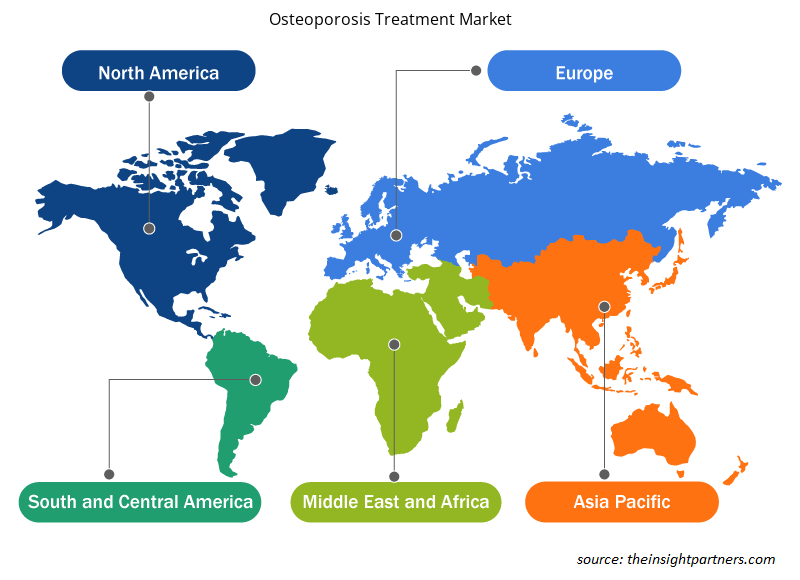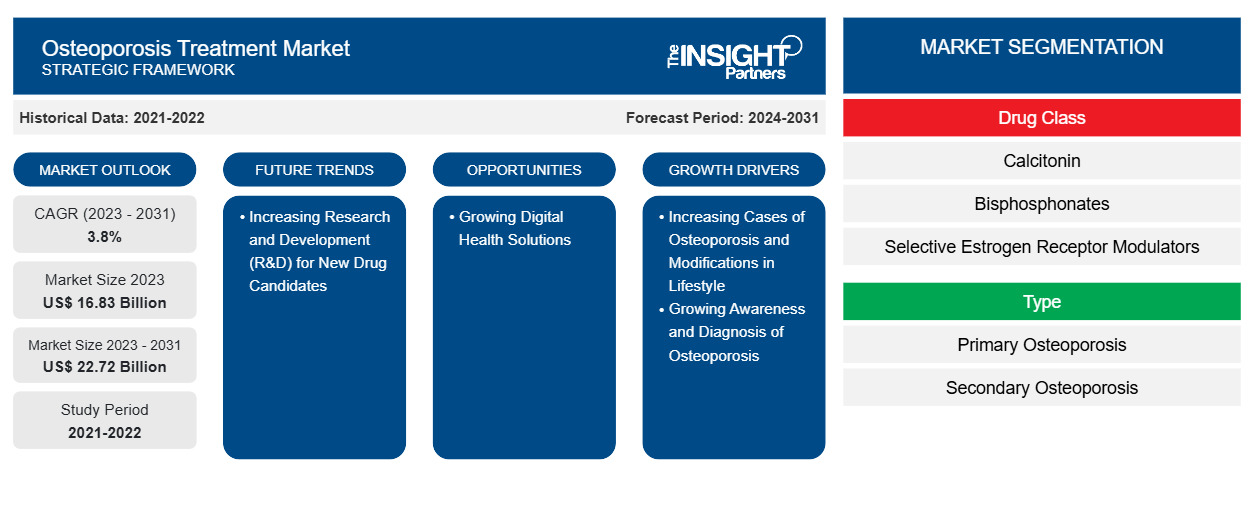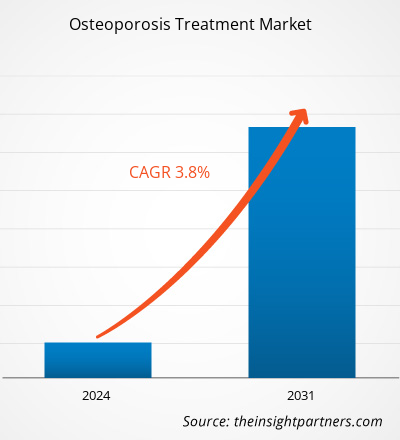骨质疏松症治疗市场规模预计将从 2023 年的 168.3 亿美元飙升至 2031 年的 227.2 亿美元;预计 2023-2031 年期间市场复合年增长率为 3.8%。
分析师观点:
该报告包括由于当前骨质疏松症治疗市场趋势及其在预测期内可预见的影响而产生的增长前景。骨质疏松症会导致骨骼变脆,以至于轻微跌倒就会导致骨折,从而影响生活质量。早期发现和治疗有助于减缓甚至阻止骨质疏松症的进展,从而降低骨折风险。因此,骨质疏松症的流行增加了诊断的需求,从而促进了骨质疏松症治疗市场的增长。由于更年期荷尔蒙变化影响骨密度,骨质疏松症主要见于女性。除了荷尔蒙变化外,增加老年人骨质疏松症风险的其他因素包括类风湿性关节炎、骨质疏松症家族史以及长期使用影响骨骼强度的药物。根据国际骨质疏松基金会的数据,在大多数骨质疏松症患者中,25% 是女性,5% 是 65 岁以上的男性。
市场概况:
骨质疏松症是一种渐进性疾病,与男性、绝经后女性和老年人的高风险骨折有关。骨质疏松症患者特别容易发生骨骼、髋部、前臂、脊柱和腕部骨折。因此,它被描述为一种代谢性疾病,会降低骨矿物质密度并导致骨折。治疗手段通常包括双膦酸盐、激素疗法、地诺单抗和一系列营养补充剂,以及生活方式的调整,如增加身体活动和富含钙的饮食。推动骨质疏松症治疗市场增长的关键因素包括医疗保健在发现和药物开发方面的支出增加,以及人们对可用于治疗骨质疏松症的药物的认识不断提高。
定制此报告以满足您的需求
您可以免费定制任何报告,包括本报告的部分内容、国家级分析、Excel 数据包,以及为初创企业和大学提供优惠和折扣
- 获取此报告的关键市场趋势。这个免费样品将包括数据分析,从市场趋势到估计和预测。
市场驱动因素:
骨质疏松症病例增多和生活方式改变推动市场增长
骨质疏松症的患病率在世界范围内不断上升,主要原因是生活方式不当、饮食不良、缺乏运动、钙和维生素 D 摄入不足以及荷尔蒙失调。根据国际骨质疏松基金会的数据,每年有超过 890 万人因骨质疏松症而骨折,每三秒钟就会发生一次骨质疏松性骨折,据估计,全球有 2 亿女性受到影响。老年人口的增加也是推动骨质疏松症治疗市场增长的重要因素。根据 Labiotech 发表的一项研究“骨质疏松症研究进展”,大约有 1000 万美国人患有骨质疏松症。约 4400 万人骨密度低,这使他们患骨质疏松症的风险增加。患骨质疏松症的风险随着年龄的增长而显著增加;据估计,50 岁及以上的成年人骨折风险很高。在美国,每年遭受髋部骨折的 65 岁及以上成年人中,有四分之三是女性,据估计,大约 15-36% 的髋部骨折患者在一年内死亡。对整体健康和保健的更广泛重视鼓励人们定期进行健康检查,包括骨密度扫描。随着个人主动监测骨骼健康,早期诊断和干预变得越来越重要,进一步刺激了市场的扩张。骨质疏松症治疗市场正因人们对骨骼健康的认识不断提高而获得巨大推动,这推动了对预防和治疗解决方案的需求。
节段分析:
骨质疏松症治疗市场分析已考虑以下部分:药物类别、类型、给药途径和分销渠道。
根据药物类别,骨质疏松症治疗市场细分为RANKL、双膦酸盐、选择性雌激素受体调节剂 (SERM)、激素疗法等。RANKL 部分在 2023 年占据了最大的市场份额。然而,激素疗法部分预计在 2023-2031 年期间的复合年增长率最高。双膦酸盐类药物在骨质疏松症治疗市场中也占有相当大的份额。双膦酸盐类药物包括阿仑膦酸盐和唑来膦酸等化合物,已被证明能有效抑制骨吸收、增加骨密度并降低骨折风险。双膦酸盐类药物具有广泛的临床历史、监管部门的批准以及口服和静脉注射剂型,因此成为医疗保健专业人士的首选。此外,它们的成本效益和全面的保险覆盖范围也使其在骨质疏松症治疗市场得到广泛应用。
根据类型,市场分为原发性骨质疏松症和继发性骨质疏松症。2023 年,原发性骨质疏松症细分市场占据了较大的骨质疏松症治疗市场份额。原发性骨质疏松症是随着年龄增长而发生的,导致骨骼更新缓慢。根据美国国家医学图书馆发表的一项名为“绝经后女性原发性骨质疏松症和低骨量患病率及相关风险因素”的研究,全球 30% 的 50 岁以上女性患有骨质疏松症。每年 8-9% 的骨折已知是由骨质疏松症引起的。此外,70 岁及以上的男性和女性会经历骨骼形成和流失之间的不平衡,导致背痛、生活质量下降和日常活动受损。
根据给药途径,骨质疏松症治疗市场分为口服和注射剂。注射剂部分在 2023 年占据了骨质疏松症治疗市场的最大份额。预计注射剂部分将在 2023-2031 年期间实现最高复合年增长率。注射剂部分在市场上的主导地位可以归因于其作为药物输送方法的有效性和可靠性。通过注射进行治疗可确保药物直接进入血液,从而快速且可预测地吸收,这是治疗骨质疏松症的一个关键优势。此外,某些骨质疏松症药物仅以注射剂形式提供,这进一步提升了其市场份额。随着患者对自我注射的依从性的提高以及创新药物输送解决方案的不断发展,注射剂部分有望保持其强大的市场地位。
区域分析:
骨质疏松症治疗市场报告的范围包括北美、欧洲、亚太地区、中东和非洲以及南美和中美洲。北美市场在 2023 年的价值为 82.6 亿美元,预计到 2031 年将达到 112.6 亿美元;预计在 2023-2031 年期间的复合年增长率为 3.9%。推动该地区市场增长的关键因素之一是该地区人口老龄化严重,人们对骨质疏松症的认识不断提高。其次,先进的医疗基础设施和全面的医疗服务使人们能够及时诊断和治疗。此外,大型制药公司的存在和持续的研发计划正在鼓励创新疗法的推出。最后,优惠的报销政策和保险覆盖支持寻求骨质疏松症治疗的患者,推动北美骨质疏松症治疗市场的发展。
亚太地区骨质疏松症治疗市场预计将创下 4.7% 的最高复合年增长率。该地区,尤其是印度和中国等国家,拥有规模庞大的制药业。中国是制药业的中心。该地区预计的市场增长归因于中产阶级的不断壮大和医疗保健可及性的提高。此外,医疗基础设施的改善和新兴的制药业使亚太地区成为骨质疏松症治疗市场显著增长和发展的中心。
骨质疏松症治疗市场区域洞察
Insight Partners 的分析师已详尽解释了预测期内影响骨质疏松症治疗市场的区域趋势和因素。本节还讨论了北美、欧洲、亚太地区、中东和非洲以及南美和中美洲的骨质疏松症治疗市场细分和地理位置。

- 获取骨质疏松症治疗市场的区域具体数据
骨质疏松症治疗市场报告范围
| 报告属性 | 细节 |
|---|---|
| 2023 年的市场规模 | 168.3亿美元 |
| 2031 年市场规模 | 227.2亿美元 |
| 全球复合年增长率(2023 - 2031) | 3.8% |
| 史料 | 2021-2022 |
| 预测期 | 2024-2031 |
| 涵盖的领域 | 按药物类别
|
| 覆盖地区和国家 | 北美
|
| 市场领导者和主要公司简介 |
|
骨质疏松症治疗市场参与者密度:了解其对业务动态的影响
骨质疏松症治疗市场正在快速增长,这得益于终端用户需求的不断增长,而这些需求又源于消费者偏好的不断变化、技术进步以及对产品优势的认识不断提高等因素。随着需求的增加,企业正在扩大其产品范围,进行创新以满足消费者的需求,并利用新兴趋势,从而进一步推动市场增长。
市场参与者密度是指在特定市场或行业内运营的企业或公司的分布情况。它表明在给定市场空间中,相对于其规模或总市场价值,有多少竞争对手(市场参与者)存在。
在骨质疏松症治疗市场运营的主要公司有:
- 辉瑞公司,
- 安进公司(Amgen Inc.)、
- 卡迪拉制药公司,
- 礼来公司,
- 第一三共株式会社
- Teva Pharmaceuticals Inc.,
免责声明:上面列出的公司没有按照任何特定顺序排列。

- 了解骨质疏松症治疗市场顶级关键参与者概况
关键球员分析:
辉瑞公司、安进公司、卡迪拉制药、礼来公司、第一三共株式会社、梯瓦制药公司、旭化成株式会社、诺华公司、中外制药株式会社和帝人制药有限公司是骨质疏松症治疗市场报告中介绍的主要参与者。
最新动态:
骨质疏松症治疗市场中的公司采用并购作为主要增长战略。根据公司新闻稿,以下列出了一些最近的市场发展情况:
- 2021年10月,领先的生物技术公司Entera Bio发布了其中期口服骨质疏松药物制剂研究的关键数据。该公司已推进该研究的3期注册。
- 2021 年 8 月,印度药品管理总局 (DCGI) 向 Enzene Biosciences Ltd 颁发了其生物仿制药 Denosumab 的营销授权 (MA),该药物用于治疗成人骨质疏松症。
- 2021年1月,总部位于伦敦的制药公司Theramex在欧洲推出了骨质疏松症药物Livogiva。
- 历史分析(2 年)、基准年、预测(7 年)及复合年增长率
- PEST 和 SWOT 分析
- 市场规模价值/数量 - 全球、区域、国家
- 行业和竞争格局
- Excel 数据集



Report Coverage
Revenue forecast, Company Analysis, Industry landscape, Growth factors, and Trends

Segment Covered
This text is related
to segments covered.

Regional Scope
North America, Europe, Asia Pacific, Middle East & Africa, South & Central America

Country Scope
This text is related
to country scope.
常见问题
The factors driving the growth of the osteoporosis treatment market include the increasing cases of osteoporosis due to modifications in lifestyle and growing awareness and diagnosis of osteoporosis.
The osteoporosis treatment market is expected to be valued at US$ 22.72 billion in 2031.
The osteoporosis treatment market majorly consists of the players such as Pfizer Inc.; Amgen Inc.; Cadila Pharmaceuticals; Eli Lilly and Company; Daiichi Sankyo Company, Limited; Teva Pharmaceuticals Inc.; Asahi Kasei Corporation; Novartis AG; Chugai Pharmaceutical Co., Ltd.; and Teijin Pharma Limited.
The osteoporosis treatment includes various drugs and therapeutic modalities carefully developed to combat osteoporosis, a disease characterized by bones becoming brittle and prone to fractures. As osteoporosis is a progressive disease, initiating the treatment at an early stage can yield better results. Osteoporosis treatment involves a series of bone density tests to determine the mineral proportion in the bones. Depending on the severity of cases, osteoporosis treatment is suggested to help reduce pain, improve mobility, and reduce the risk of disability.
The osteoporosis treatment market was valued at US$ 16.83 billion in 2023.
The global osteoporosis treatment market, Based on drug class, the osteoporosis treatment market is segmented into RANKL, bisphosphonates, selective estrogen receptor modulators (SERM), hormone therapies, and others. The RANKL segment held the largest osteoporosis treatment market share in 2023. However, the hormone therapies segment is predicted to register the highest CAGR during 2021–2031. Based on type, is bifurcated into primary osteoporosis and secondary osteoporosis. The primary osteoporosis segment held a larger market share in 2023 and is estimated to record a faster CAGR during 2023–2031. Based on end user, the market is segmented into hospital pharmacies, retail pharmacies, and online pharmacies. The hospital pharmacies segment held the largest osteoporosis treatment market share in 2023 and is estimated to register the highest CAGR during the forecasted period.
Trends and growth analysis reports related to Life Sciences : READ MORE..
The List of Companies - Osteoporosis Treatment Market
- Pfizer Inc.
- Amgen Inc.
- Cadila Pharmaceuticals
- Eli Lilly and Company
- Daiichi Sankyo Company, Limited
- Teva Pharmaceuticals Inc.
- Asahi Kasei Corporation
- Novartis AG
- Chugai Pharmaceutical Co., Ltd.
- Teijin Pharma Limited
The Insight Partners performs research in 4 major stages: Data Collection & Secondary Research, Primary Research, Data Analysis and Data Triangulation & Final Review.
- Data Collection and Secondary Research:
As a market research and consulting firm operating from a decade, we have published and advised several client across the globe. First step for any study will start with an assessment of currently available data and insights from existing reports. Further, historical and current market information is collected from Investor Presentations, Annual Reports, SEC Filings, etc., and other information related to company’s performance and market positioning are gathered from Paid Databases (Factiva, Hoovers, and Reuters) and various other publications available in public domain.
Several associations trade associates, technical forums, institutes, societies and organization are accessed to gain technical as well as market related insights through their publications such as research papers, blogs and press releases related to the studies are referred to get cues about the market. Further, white papers, journals, magazines, and other news articles published in last 3 years are scrutinized and analyzed to understand the current market trends.
- Primary Research:
The primarily interview analysis comprise of data obtained from industry participants interview and answers to survey questions gathered by in-house primary team.
For primary research, interviews are conducted with industry experts/CEOs/Marketing Managers/VPs/Subject Matter Experts from both demand and supply side to get a 360-degree view of the market. The primary team conducts several interviews based on the complexity of the markets to understand the various market trends and dynamics which makes research more credible and precise.
A typical research interview fulfils the following functions:
- Provides first-hand information on the market size, market trends, growth trends, competitive landscape, and outlook
- Validates and strengthens in-house secondary research findings
- Develops the analysis team’s expertise and market understanding
Primary research involves email interactions and telephone interviews for each market, category, segment, and sub-segment across geographies. The participants who typically take part in such a process include, but are not limited to:
- Industry participants: VPs, business development managers, market intelligence managers and national sales managers
- Outside experts: Valuation experts, research analysts and key opinion leaders specializing in the electronics and semiconductor industry.
Below is the breakup of our primary respondents by company, designation, and region:

Once we receive the confirmation from primary research sources or primary respondents, we finalize the base year market estimation and forecast the data as per the macroeconomic and microeconomic factors assessed during data collection.
- Data Analysis:
Once data is validated through both secondary as well as primary respondents, we finalize the market estimations by hypothesis formulation and factor analysis at regional and country level.
- Macro-Economic Factor Analysis:
We analyse macroeconomic indicators such the gross domestic product (GDP), increase in the demand for goods and services across industries, technological advancement, regional economic growth, governmental policies, the influence of COVID-19, PEST analysis, and other aspects. This analysis aids in setting benchmarks for various nations/regions and approximating market splits. Additionally, the general trend of the aforementioned components aid in determining the market's development possibilities.
- Country Level Data:
Various factors that are especially aligned to the country are taken into account to determine the market size for a certain area and country, including the presence of vendors, such as headquarters and offices, the country's GDP, demand patterns, and industry growth. To comprehend the market dynamics for the nation, a number of growth variables, inhibitors, application areas, and current market trends are researched. The aforementioned elements aid in determining the country's overall market's growth potential.
- Company Profile:
The “Table of Contents” is formulated by listing and analyzing more than 25 - 30 companies operating in the market ecosystem across geographies. However, we profile only 10 companies as a standard practice in our syndicate reports. These 10 companies comprise leading, emerging, and regional players. Nonetheless, our analysis is not restricted to the 10 listed companies, we also analyze other companies present in the market to develop a holistic view and understand the prevailing trends. The “Company Profiles” section in the report covers key facts, business description, products & services, financial information, SWOT analysis, and key developments. The financial information presented is extracted from the annual reports and official documents of the publicly listed companies. Upon collecting the information for the sections of respective companies, we verify them via various primary sources and then compile the data in respective company profiles. The company level information helps us in deriving the base number as well as in forecasting the market size.
- Developing Base Number:
Aggregation of sales statistics (2020-2022) and macro-economic factor, and other secondary and primary research insights are utilized to arrive at base number and related market shares for 2022. The data gaps are identified in this step and relevant market data is analyzed, collected from paid primary interviews or databases. On finalizing the base year market size, forecasts are developed on the basis of macro-economic, industry and market growth factors and company level analysis.
- Data Triangulation and Final Review:
The market findings and base year market size calculations are validated from supply as well as demand side. Demand side validations are based on macro-economic factor analysis and benchmarks for respective regions and countries. In case of supply side validations, revenues of major companies are estimated (in case not available) based on industry benchmark, approximate number of employees, product portfolio, and primary interviews revenues are gathered. Further revenue from target product/service segment is assessed to avoid overshooting of market statistics. In case of heavy deviations between supply and demand side values, all thes steps are repeated to achieve synchronization.
We follow an iterative model, wherein we share our research findings with Subject Matter Experts (SME’s) and Key Opinion Leaders (KOLs) until consensus view of the market is not formulated – this model negates any drastic deviation in the opinions of experts. Only validated and universally acceptable research findings are quoted in our reports.
We have important check points that we use to validate our research findings – which we call – data triangulation, where we validate the information, we generate from secondary sources with primary interviews and then we re-validate with our internal data bases and Subject matter experts. This comprehensive model enables us to deliver high quality, reliable data in shortest possible time.


 获取此报告的免费样本
获取此报告的免费样本